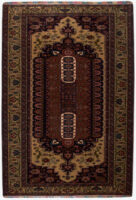Om Quchan
Quchan, Gouchan, Guchan, Gochan, Ghombad-Ghabuz, Kurdi-Belouch Gouchan carpets, Kurdi-Belouch and Ghombad-Ghabuz are knotted in the area west, north-west of Mashad by nomads and local farmers. The patterns are simple, with motifs such as ram horns, scorpions, octagons and large stylised medallions. Some of the motifs are often knotted in silk....Read more
Showing all 5 results
-

Quchan Tæppe
hh878401R28cm x 22cmkr. 590,- -

Quchan Tæppe
hh87842IR28cm x 23cmkr. 590,- -

Quchan Tæppe
hh878411R28cm x 23cmkr. 590,- -

Quchan Tæppe
tg5213181cm x 130cmkr. 14.800,- -

Quchan Tæppe
tg03684191cm x 133cmTilbudSale! kr. 7.920,- (-60%)
Showing all 5 results
Mere om Quchan
Quchan, Gouchan, Guchan, Gochan, Ghombad-Ghabuz, Kurdi-Belouch
Gouchan carpets, Kurdi-Belouch and Ghombad-Ghabuz are knotted in the area west, north-west of Mashad by nomads and local farmers. The patterns are simple, with motifs such as ram horns, scorpions, octagons and large stylised medallions. Some of the motifs are often knotted in silk. Overall, they are very inspired by the patterns from the Azerbaijan area (the north-western part of Iran and the border area towards Turkey and Russia). The colours consist of warm red, golden, orange and black. The wool is dyed with natural dyes and the Senneh knot is used. The warp and weft can be made from either wool, cotton or silk. They can have up to 750,000 knots per m2.
Read more about Mashad:
Mashad, Mashhad, Maschad, Meshad
The capital in Khorassan is called Mashad. Many people describe it as the most beautiful city in Iran after Isfahan, and it is located about 1000 metres above sea level, in the middle of a fertile oasis. Mashad is the most important pilgrimage town in Iran. Here, you can find Imam Reza’s Mausoleum. In the year 818, the eighth Imam Reza (Ali al-Ridâ) was poisoned and killed by al-Ma’mûn, and the town has since been known as ‘The City of Martyrs”. In the period under the Safavids (1502-1736), shah Abbas undertook a pilgrimage to Mashad, and in 1602, he commissioned the building of a beautiful mosque with a golden dome above the tomb.
Fakta om Mashad
Facts about Mashad Mashad is located in north-eastern Iran in the Khorasan province. The town has more than 2.5 million inhabitants and is one of Iran’s most sacred cities. This is where the prophet Imam Reza is buried. Visiting Mashad is an important part of the pilgrimage for a Shia Muslim. Today, Mashad is a very important carpet town, and it is also a gathering point for the carpets that are made by the numerous nomads in the area. The town is famous for its good quality wool. At the bazaar, we were told that many breeders produce such good wool that it is sold to other areas. Saying ‘Pashme-i-Mashad’ (‘the wool is from Mashad’) is regarded as a good sales argument and adds a nice bonus. It is also a wonderful experience to see the bazaar, with carpets everywhere, all of which were made in the area, and to see and feel them and still marvel at how different they are. Good, durable carpets are knotted in the actual town of Mashad. The pattern is cultivated and tasteful, with a central medallion, and the ground colour is usually red. It is an easily recognisable shade of violet-red. This colour is obtained from the cochineal red dye used here, which is different from the madder red used in most other places. The Senneh knot (Persian knot) is used, and the knot density is usually between 18,500-46,000 knots per ft2. The most famous workshop ever in Mashad was Soltan Ibrahim Mriza. Later, others were established, such as Amoghli, Khamenei and Zarbaf. Amoghli was one of the most recognised carpet workshops in Persia in the 20th century, under Ali Khan Amoghli and Abdol Mohammad Amoghli. Their carpets were among the favourites at the shah’s palaces during the Pahlavi dynasty.
Source:
You are reading an extract from the book ‘Oriental Carpets, Knottet with Love’ by Martin Munkholm.
This extensive book about all that is carpets can be borrowed in Danish libraries or be bought following this link: https://belle-rugs.dk/vare/bog-aegte-taepper-knyttet-med-kaerlighed/
The book is published by Muusmann Forlag.
For more info: http://muusmann-forlag.dk/
You can find our selection of Quchan carpets underneath.
